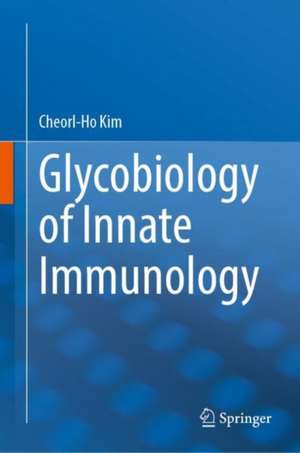Glycobiology of Innate Immunology
Autor Cheorl-Ho Kimen Limba Engleză Hardback – apr 2022
This book opens by providing the key background on glycans in innate immunity and its mechanisms behind the Dendritic cell interactions during infection and inflammation are examined in depth, and the concluding chapter is devoted to signaling tumor immunotherapy. Up-to-date information is then presented on all aspects of glycan structure-recognizing signaling. The book should assist in the further development of new strategies against emerging infectious agents and intractable diseases.
| Toate formatele și edițiile | Preț | Express |
|---|---|---|
| Paperback (1) | 962.49 lei 6-8 săpt. | |
| Springer Nature Singapore – 2 apr 2023 | 962.49 lei 6-8 săpt. | |
| Hardback (1) | 970.77 lei 6-8 săpt. | |
| Springer Nature Singapore – apr 2022 | 970.77 lei 6-8 săpt. |
Preț: 970.77 lei
Preț vechi: 1183.86 lei
-18% Nou
Puncte Express: 1456
Preț estimativ în valută:
185.75€ • 193.94$ • 153.74£
185.75€ • 193.94$ • 153.74£
Carte tipărită la comandă
Livrare economică 04-18 aprilie
Preluare comenzi: 021 569.72.76
Specificații
ISBN-13: 9789811690808
ISBN-10: 9811690804
Pagini: 656
Ilustrații: XIX, 656 p. 1 illus.
Dimensiuni: 155 x 235 mm
Greutate: 1.17 kg
Ediția:1st ed. 2022
Editura: Springer Nature Singapore
Colecția Springer
Locul publicării:Singapore, Singapore
ISBN-10: 9811690804
Pagini: 656
Ilustrații: XIX, 656 p. 1 illus.
Dimensiuni: 155 x 235 mm
Greutate: 1.17 kg
Ediția:1st ed. 2022
Editura: Springer Nature Singapore
Colecția Springer
Locul publicării:Singapore, Singapore
Cuprins
Part 1. Glycans in innate immunity of dendritic cells.- Chapter 1) Historical expansion of defense system.- Chapter 2) Columbus era to modern revolution in immunological defense system.- Chapter 3) Historical profile of defense constituents and progress in innte immune repertoire.- Chapter 4) The outline of innate immunity.- Chapter 5) Autophagy from microbial invaders and self-associated molecular patterns (SAMPs) of innate immune cells.- Part 2. Dendritic cells (DCs).- Chapter 6) General biology of DCs.- Chapter 7) Classification and different function of DCs.- Chapter 8) Glycan biosynthesis in eukaryotes.- Chapter 9) Glycans in cell recognition and evolutionary adaptation in organisms.- Chapter 10) Changes in glycan structure involve in co-regulated expression of glycan-binding lectin counterparts.- Chapter 11) Evolution of lectin: alternative splicing contributes to variation for glycan binding receptors.- Chapter 12) Glycan regulation of NK cell receptors.- Chapter 13) Carbohydrate recognition of target antigens by DCs during infection and inflammation.- Chapter 14) Glycan-specific trafficking receptors in DCs maturation.- Chapter 15) Glycan ligands in trafficking of DC migration.- Chapter 16) Chemokine receptors in DCs trafficking.- Chapter 17) Glycan structure-recognizing selectins in DC-endothelium interaction during infection and inflammation.- Chapter 18) Glycans activate the innate immune system.- Chapter 19) Innate immune lectin receptors of Siglec, DC-SIGN, Galectin and TLR in DCs.- Chapter 20) Galectins.- Chapter 21) DC-specific ICAM-3-grabbing non-integrin, DC-SIGNB (CD209).- Chapter 22) Other DCs-derivd receptors.- Chapter 23) Toll-like receptors (TLRs).- Chapter 24) CD33 and CD33-related Siglecs in pathogen recognition and endocytosis of DC in the innate immune system.- Chapter 25) Pathogenic suppression of the pathogen-specific host immune response.- Chapter 26) DCs tumor immunotherapy through sialyl binding of DCs to T cells.
Notă biografică
Prof. Cheorl-Ho Kim
Molecular and Cellular Glycobiology Unit, Department of Biological Sciences, Sungkyunkwan University
Textul de pe ultima copertă
This book presents the latest knowledge and the most recent research results on glycobiology of innate immunology. Innate immunity is the crucial part of the immunological defense system that exerts their distinct functions through binding to certain functional glycoproteins. They play a role in various human diseases and also function against microbial invaders and self-associated molecular patterns. Co-regulated expression of glycan-binding is associated with many biological components such as cellular oncotransformation, phenotype change, neuronal or embryonic development, regulation of cell division, cell–cell interaction, cell attachment, adhesion, and motility, and intracellular signaling via protein–carbohydrate or carbohydrate–carbohydrate interactions.
This book opens by providing the key background on glycans in innate immunity and its mechanisms behind the Dendritic cell interactions during infection and inflammation are examined in depth, and the concluding chapter is devoted to signaling tumor immunotherapy. Up-to-date information is then presented on all aspects of glycan structure-recognizing signaling. The book should assist in the further development of new strategies against emerging infectious agents and intractable diseases.
This book opens by providing the key background on glycans in innate immunity and its mechanisms behind the Dendritic cell interactions during infection and inflammation are examined in depth, and the concluding chapter is devoted to signaling tumor immunotherapy. Up-to-date information is then presented on all aspects of glycan structure-recognizing signaling. The book should assist in the further development of new strategies against emerging infectious agents and intractable diseases.
Caracteristici
Presents the latest research results in the field
Covers all aspects of glycan-mediated signaling and its regulations
Examines various glycan interactions during infection and inflammation
Covers all aspects of glycan-mediated signaling and its regulations
Examines various glycan interactions during infection and inflammation
